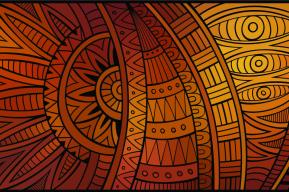Article
200 years before Gutenberg: The master printers of Koryo

The oldest surviving woodblock print in the world seems to be the Pure Light Dharani-sutra, a small Buddhist scroll discovered in 1966 at the Pulguk-sa Temple in Kyongju. Scholars have deduced that it was published under the Silla dynasty, around 751 A.D.
Ch'on Hye-bong
Johannes Gutenberg, a fifteenthcentury German craftsman and inventor, is widely believed to have been the first man to produce a font of movable metal type. This belief is mistaken. This momentous invention had been anticipated over two centuries before in Korea, where no less than six distinct fonts of metal type had been created by the time the famous Gutenberg Bible was printed.
According to Lee Kyu-bo, an illustrious man of letters who was also the prime minister of King Kojong of the Koryo dynasty, the first book to be printed with metal type was produced around 1234. In a book of his own he describes how twentyeight copies of a Confucian work entitled the Sang-jong-ye-mun ("Detailed Text for Rites of the Past and Present") were produced and distributed to various government offices.
This great innovation occurred in a country where the art of printing already had a long history. More than seven hundred years before Gutenberg and five hundred years before the invention of movable metal type, artists under the Silla dynasty had achieved great proficiency in woodblock printing.
Woodblock printing is an art form which reached a high level of development in many parts of east Asia, but the achievements of Korea in this field are so remarkable as to support the view that the most brilliant accomplishments are often fostered within the smaller cultures.
Historians acknowledge that the Chinese invented xylographie (woodblock) printing between 712 and 756 during the great age of T'ang culture. At that time Korea's ruling Silla dynasty was in very close contact with China as a result of a military alliance with the T'ang dynasty which had led directly to the unification of the Korean peninsula. Therefore it may be assumed that knowledge of printing using carved wooden blocks reached Korea soon after its invention.
The oldest surviving woodblock print in the world seems to be the Pure Light Dharani-sutra, a small Buddhist scroll discovered in 1966 at the Pulguk-sa Temple in Kyongju. Scholars have deduced that it was published under Silla patronage around 751 A.D.
The oldest surviving Chinese woodblock scroll is the Diamond-sutra, which was printed in 868 under the T'ang dynasty by Wang Chieh for the purpose of praying for the souls of his dead parents. Comparison of this scroll with the Korean sutra from Pulguk-sa reveals that the Korean product, while displaying similar excellence of workmanship, unmistakably shows features of an earlier age.
The art of printing was further developed in the early years of the Koryo period (918- 1392). The Precious Box Seal Dharanisutra, a scroll published by Ch'ongji-sa Temple in 1007, is a work of exquisite skill and is undoubtedly the best of all such works dating from the early years of the Koryo dynasty.
Tripitaka Koreana
But the greatest of the Koryo accomplishments in the art of woodblock printing, and perhaps in all the arts, is the monumental 6,000-chapter Tripitaka Koreana, based on a Buddhist text imported from Sung China in 991. This project was motivated by the desire to enlist the aid of the Buddha in an attempt to withstand invasion.
The first set of woodblocks, completed in 1013, was destroyed two centuries later when the Mongols invaded Korea in 1232. The invaders ravaged the entire country except for the island of Kanghwa off the west coast, where the king and the court took refuge. It was here that the government-in-exile began the mammoth task of restoring the destroyed Buddhist books. The work went on for sixteen years and resulted in over 80,000 woodcut blocks which are today preserved in the Haein-sa Temple. A precious source for the study of Buddhism, the Tripitaka has a strong claim to be considered Koryo's finest product in the arts.
Whatever the truth of this claim, it is indisputable that the invention of movable metal type was Koryo's overwhelming contribution to science and technology. The technological capability existed by the early thirteenth century in the form of suitable papers and inks and in the availability of sufficient metalworking knowledge. The need for books to be produced in a number of copies was driven home when the royal palace of Koryo, along with tens of thousands of books in the royal library, was twice destroyed by fire, in 1126 and 1170. At the same time China, a major source of book supply, was preoccupied with wars which caused a decline in book output. Further stimuli included a growing scarcity of wood suitable for making printing blocks, an abundance of bronze, and the prospect of reduced costs from using a type font on many occasions.
And yet the promoters of movable metal type were initially to be disappointed, for their innovation did not win general acceptance. To the Koreans a book was both a store of knowledge and a work of art, and the unsurpassable beauty and fineness of detail achieved with wood was to relegate this new technique to the status of a minor oddity for the next one hundred and seventy years.
It was not until 1403 that T'aejong, the second king of the Yi dynasty, revived the neglected technique when he initiated the casting of bronze type for the printing of Confucian classics and historical literature with the aim of helping government officials to rule wisely. His type font was revised by his son, King Sejong, the most beloved of all Korean rulers, and there ensued a series of technological improvements which by the end of the fifteenth century resulted in the printing of books as beautiful as any produced with wood.
Share
About the authors
Professor of history and bibliography and director of the university library, Sungkyunkwan University, Seoul, Ch'on Hye-bong is the author of numerous articles on ancient Korean printing techniques.







